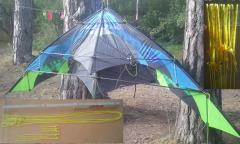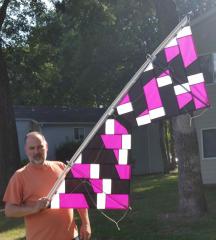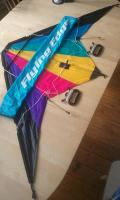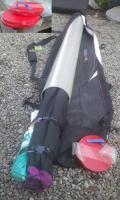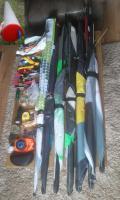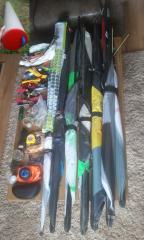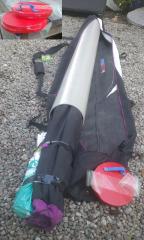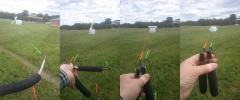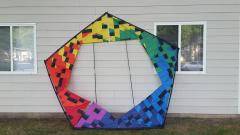-
Posts
580 -
Joined
-
Last visited
-
Days Won
27
Content Type
Profiles
Forums
Gallery
Downloads
KL Shop
Blogs
Articles
Everything posted by Exult
-
The only kite in my set of kites that I have not flown yet is my Vapor, mostly because I not initially could make my mind up whether I should keep it or not (after all the cost per weight was incredible) and then have been occupied with other projects. Normally I have the idea that kiting should be a kind of affordable activity in terms of cost per session (I know that the choice of that figure of merit is a matter of preference and that we all a re different and that there are more aspects than this - e.g. it is difficult set a universally valid price on the beauty of a kite). None the less, disregarding the economics, what is the feeling when handling the kite including the time before and after the flight - wearing silk gloves, fearing that the sail would be punctured or is the kite instead quite robust? Should one fear gusts or would it be better if less walking/running would be required to keep it in the air in low wind? How is the (frame weight/over all) trade off between light wind properties and trickiness?
-

Think Positive! - a mostly QLK blog entry for a change
Exult posted a blog entry in Exult's Gentle Breeze
Sun Aug 6 13:00:00 CEST 2017 GF, forecasted (not applicable - didn't seem to match) Rev B-series standard, 2 wrap tubes most of the time Lines 25m, 60kg (front) and 40kg (rear) Today's winds were a bit erratic and mostly weak. It was cloudy and the ground was a bit moist from recent rain. When I came to the field I realized that I had forgotten the kite stake at home (an old screwdriver with red tape wound around the handle). Normally I never deal with them, but then "normally" until some months ago meant one DLK. I find kite stakes handy in two cases. When having the DLK lines connected with a bar (as when doing two DLKs) relaunching the kite can be tricky if the kite has happened to tumble on the ground a bit - I have never managed to do a cart wheel with a bar handle. The other standard and obvious use of a kite stake is when keeping the QLK on the ground set up for an easy relaunch. During a dip in wind period (wind below walking speed) I took a break, sat comfortably on the usually annoying beach outdoor furniture (is somewhat in the way of kiting) and watched the sky - a grey mass of Cumulonimbus like clouds was approaching from the southwest. The wind picked up somewhat again - another chance to get going again. Today's intended focus was the clock work and flying squares in a clock work like way, but with straight paths with sudden starts/stops in between the 90 deg turns. Some work remains to be done here... A little detail, when flying the squares (clockwise) the largest deviation from the intended path starts in the top right corner. The top right corner I've traditionally used to do a 3/4 CCW turn to untwist the lines when flying DLKs. I've later practiced to instead make the 1/4 CW turn in the top right corner (which I was not used to) look good. Are DLK and QLK that close so that old weaknesses comes back and influence the other activity? In every session I include inverted flight going upwards as suggested by @Paul LaMasters : Thank you for this good and really long lasting exercise suggestion! I'm still very much looking for those railroad tracks somewhere. The Cumulonimbus clouds delivered their load. Shortly before that, the wind had picked up somewhat for a while - perhaps it was the type of wind that heavy rainfall creates when the downwards wind inside the cloud (that is driven by the rain itself) is forced sideways by the ground. Initially I tried to disregard the light rainfall, but a wet/heavy kite in mostly low wind proved to be difficult and then it really started to rain - cats and dogs! Quickly wind up the lines and bring the whole kite still assembled to the car. Minor field unboxing event residue (the label i.e.). So low and a bit funny winds, no kite stake and then driven of the field by heavy rainfall, where to look for the positive angle? You can find them!: The low wind. For the first time I switched to the 2wrap frame - yes a bit of an unboxing event. I much appreciated the added ease of keeping it in the air and the more reachable flex that can propel the kite forward when adding tension to the lines. No kite stake. Another thing that got necessary to practice was the flat launch of the type with kite face down on the ground and the LE away from you. This position was today the starting/parking position available with no kite stake. I was helped in this by the low wind and smooth lawn. The wet weather. No one was was competing for the lawn/beach area. People seem to be very influenced by the weather when choosing activity. When the rainfall became heavy, it was also a natural situation to test the method of getting the whole QLK in the car as suggested by @SHBKF in http://kitelife.com/forum/gallery/image/6080-reflex-in-sierra/ . It worked! Hurry, hurry to the car - no time to dissassemble the kite. Did lower the tip under the dashboard so that I could use the right wing mirror before driving home. Always look on the bright side of Life! -

Prism 25th Anniversary Special Edition Quantum
Exult replied to JaseRicco's topic in Kite Photographs
For those historically inclined collectors who do not mind to spend some extra on shipment, the only Prism dealer in Sweden still got one Radian in stock for sale according to their web site. Same colours as the Quantum here it looks like. -
@John Barresi, it certainly looks gravity defying when you pull the lines and speed the kite up when it is going downwards and you instantly carry on like nothing happened. Normally I'm used to in low wind flying that you relax lines and gain ground when the kite is going downwards, but then I've never used a Prodancer SUL. The video gives a speedy rather than a slow floaty impression kind of (if viewed casually) hiding that it is a low wind session. An enjoyment to watch! Added 5th of August (two days later): And it also serves as an illustration/reminder of that you can have fun with trickless DLKing and is an inspiration on actively flying by powering up/down the kite/lines. Today however it instead served as a reminder in a quite different situation to practice the sail loading on/off when using my full vent quad.
-
Yes I completely agree (had a kite shop in Germany import it from US for me to get it - never did any corresponding waiting/procedure for any other kite). It is the kite that got me going with half axel cascades (and is still the kite I perform them best with). You don't need to set the kite up properly, you more or less do it by only pulling the top wing when doing the half axels (at least when the wind is not to light). My other kites require more input/help here. Also the Hydra is my favourite kite when doing inputs of the type that you don't know the outcome of. Yes, this is very far from tricking like it looks like it is on purpose, but I hope it is a way of avoiding getting stuck in the moves that I'm used to and hopefully makes me continuing with development. Even though I strive for that the tricking should look like it is on purpose, it is my belief that one need to let go of it (i.e. pausing figure flying and sometimes even the fine polishing repetition part of tricking), dare to do the early part of a learning a new trick (or just experiment) without thinking of if it looks well or not. To increase the percentage of time in non-ordinary flying positions or transitions between them, to make it close to normal (and increase understanding/experience of kite movements I usually do not end up doing otherwise) was the main theme of my attempts during the (early) spring (before I got distracted by other stuff and above all distracted myself with various other kite projects).
-
I wonder how it looks like when a quad sail gets stretched and how it feels like using it. Is it possible to do some advanced kite surgery to save the sail by redoing some seams and add or take away material to compensate for the stretch?
-
Sounds like you have a high wind kite and a no-one-else-got-it kite as well. Nothing wrong with a cheap foil IMO. You might be lucky, you might get some ideas of what to improve or decide for a more expensive but a safer bet later. In either case you win by gaining experience. I also got one cheaply because I was curious of the kite type and then much later tried it out ( http://kitelife.com/forum/blogs/entry/191-learning-from-flying-in-unfamiliar-or-non-ideal-situations/ ). When your skills allow it? If you know DLKs I believe that if/when starting out with QLKing you have much knowledge of the starting-out-and-getting-going sort for free. I started out quite recently and can unfortunately only refer to my experiences. However comparing to someone who knows it profoundly (e.g. and randomly https://www.youtube.com/watch?v=EKD8UDGmQAM ) I'm afraid my flying is much limited and looks like it would be performed by a drunken pilot.
-
Hmm, I'm to lazy to do both velcro straps/wraps and kite sleeves. Do you (everyone) use the velcro straps with or without sleeves? I recently shifted from mostly using kites-in-sleeves-in-bags to kites-kept-wrapped-by-velcro-straps-put-in-bags for my duals (my two QLKs are still in sleeves - just to be somewhat inconstant). Would you expect more wear and tear during transport (walks, public transport and cars) when skipping the sleeves? I have marked most of my spars that could be possible to mix up (if they would escape from their kite roll). When finished I connect the spars (belonging to a certain kite) with a rubber band (have an abundance of them), roll the sail around the spars until the roll meet the LEs/spine (the rolling part is like in the Kymera instructional video) and then put the velcro strap around (or sometimes put the kite in its sleeve). I have broken a LE/spreader fitting in early kiting days, so I've always been a bit careful not to do this. Perhaps it was just a bad sample or even cold weather? Anyone ever seen them (of any sort) break due to this?
-
Finally I hear this from someone else that also seems to have done this observation! Have long lines to reach over the low winds close to the ground is another take on it. So far the standard recommendation I found is just to go to shorter lines. Talking about wind ranges, I've flown my full vent as a standard, mid vent and full vent, by adding patches. It has worked in doing what it is supposed to, but the tested method can be further improved. For the patches to stick better, it is an advantage to attach them at home and not in the field in a hurry without any flat surfaces available.
-
I've said it before, but this is my main inspirational video ( https://www.youtube.com/watch?v=yvUJ9bxB0Gc ). One day, one day I hope to resemble this in flying. Not just fly with intent, but also make the tricking look like it is all on purpose!
-

Low Wind Kite Suggestions - Silver Fox It Is
Exult replied to JaseRicco's topic in General Sport Kite
The only kites I've tested (and own) in the lower/medium (?) price segment is the Prism 4D and the HQ Shadow (and no boutique grade kites at all). The Shadow I'd say is a low wind kite with much preserved trickiness compared to the 4D. On the other hand I'd say that the 4D manages low wind slightly better and is very portable. On one occasion this summer using 15m 25kg lines in low wind I could just do the 360ies (i.e. making the kite fly around you in a circle by running in a smaller circle) with the 4D, but I failed mostly with the Shadow. On the other hand, for me reliable 360ies is work in progress (or is currently "stalled"?). In the beginning I could hardly do any tricks on the 4D, but after a year (corresponding to about 10 4D sessions perhaps) I felt satisfied when my tricking on the 4D improved somewhat and it started to feel more like "a real kite". My guess is that you would feel most familiar with the Shadow if you are already used to a standard kite. Also while you are waiting to find that perfect low wind kite you can still practice low wind stuff in low wind with your standard kite such as gaining ground, pop up launches, belly landings, stalls... Make small jumps from the ground and land slowly - you are now practicing stalls, landings, starts, general control and, if needed, handling "fear" of the ground... -
From the album: Exult's Photos
My latest project is my first stack. Yes, I probably should start with something smaller, but too much pull has not been a problem so far with these kites. I've had much respect for the wind when using the Fazer XXL (or rather when choosing to use it or not) which has resulted in much physical exercise when keeping it in the air. Slightly remarkable IMO is the opinion of my mother in law: "The green kite looks better than the blue one". I've been flying the Fazer XXL in spite of its look. I have also ever heard that it ever looks good from anyone anywhere any time. However I've gradually gotten used to its appearance, but can't say it is one of my better looking kites. My plan for the stack is to fit two Prism 75 feet black and white tube tails to each of the XXL wingtips and possibly a 1m line laundry rotor (will slow down too much?) to to the XL spine. I learnt about stacking from: http://kitelife.com/forum/topic/6478-setting-up-a-stack/, Prism stacking instructions and Highflykites > Kite manuals > Stunt kite manual (part 2) > Stacking stuntkites. I added pig tail like connectors on the first kite (XL) to be able to connect the kites quickly and to trim the angle of the last kite. I use a Liros 200daN/kg (440lbs) bridle line (Dyneema with a polyester sheath). It is about 2mm in diameter and roughly matches the bridle diameter (strength?) of the smaller first kite (Fazer XL). I don't know when I'll be able to test the stack. The size should make the wind range narrower. The upper is of course how much sail you can manage in high wind. The lower limit I expect to be fixed, possibly increased a bit due to complexity and that I'm not being used to stacks. And besides, vacation is over and it's back to work now. Another thing that might limit future kiting sessions is my quest during the last three months to reduce the number of: "I always wanted to but I never did"s. I've devoted much spare time to kiting during this period when doing so, which starts to be somewhat less popular with my family. However during this time I have (or started to): learnt to fly two DLKs, experimented with multi kite handles, built the kite bag transport armor, got started with quads, experimented with patching full vent into a mid vent and a standard, gotten hold of a sewing machine (and made a small bag just to learn the sewing machine basics) and now I've finished (but not tested/trimmed) my first stack. Before that it was piloting DLKs "only" and made occasional repairs. Kiting is currently somewhat with the sense of being a Jack of all trades but master of none. Perhaps it is time to instead focus on depth on what I've started rather than covering new areas of kiting for a while. -
I think you asked a good question @JaseRicco (which I noticed that I missed the details of and instead answered the more general question as asked in the topic headline). My recommendation (though I haven't tried neither the Nexus nor the Quantum, but for reasons as below): Keep the Nexus! Reasons for many kites: Trick learning. You typically learn a trick on one kite that is more natural for that certain kite. You then transfer it to other kites. Many kites are an encouragement to try something new. A library of properties. Any kite that you have used a lot becomes a kind of reference. Moves of interest you achieved with a kite a long time ago are still there. E.g. when I started my second period of more serious kiting about 2.5 years ago I got a couple of old (as in model, new in terms of use) Prism kites for a good price, but when I picked up my old much used HQ Jam Session it felt like I was instantly at home - I had not used it during this millennium however except for a couple of times (<5 times in the first few years of it). I don't want to loose the effort/experience that I have invested in a kite by parting from it. A guest kite. A durable kite that you don't care for much yourself to allow guests to do the mandatory lawn darts. The guest can be someone you end up talking to at the field or someone invited. I have a HQ quickstep 2 on long and better lines than those that came with the kite. What is good about that kite, is that it, is cheap, doesn't know that is small and ought to be twitchy, but turns slowly as a much larger kite and also that it just doesn't break. Wind ranges of different kites. As several others stated above, this is an important one. Pick the kite of the available ones that suites the wind best! Kite properties are more secondary for decent kites at least. The wind range argument is also something that my wife can grasp, which can be of use when acquiring kites. Stacks and multi kiting. Obviously you need more than one kite here and in neither case there is the requirement of identical kites. Curiosity. How would that kite be like? It can be that you have read about a kite and think that its properties would suit you or make you evolve, you have seen a video and got inspired (warning, someone that is extremely good is likely to be the pilot in that video) or you might want to try something different like larger kites, precision biased kites, speed kites, foils, gliders or QLKs. The object of your curiosity can be a new kite or one that remains to be further investigated. Unfortunately I don't have access to OPKs (other peoples kites - no serious DLK (or QLK) kiters seems to be around here to my knowledge), so if I want to try something I need to buy it. Also a kite that you don't understand at the time of purchase might make sense later. I didn't like the light frame of my City Session (bought it by the end of the 90-ies and just used it a couple of times due to the light frame), but now after having gotten used to the Prism 4D and HQ Shadow I should reevaluate it. Availability of kites (added 2nd of Aug.). The kites should be at hand when you need them. Dependent upon your situation that extra set of kites could be at work, in the car (warning cars when parked in the sun can get very hot - can your kites take it?) or at an alternative place of living. Imagine a good day at work and you manage to finish in time, get a phone call from home saying that you have no obligations this afternoon/evening and that the conditions are good - wouldn't you then wish that you had a couple of kites at work? Position the kites that don't see much air strategically and get those old sins (broken kites) repaired so that they can turn into spare kites.
-
-
Both the Hydra and Kymera belong to my favourite set of kites and I do not find the humming (only there in stronger winds) annoying. My guessing is that the Kymera camber is there to make it a good flyer with a large wind window and the humming to prevent it from becoming somewhat of a heavy pulling speed kite. No, my ITW Hydra does not have a leech line, but perhaps there is a difference between the ITW Hydra and earlier Focus Hydra (no, not the HQ Hydra power kite). I don't know if there is supposed to be any differences here either.
-
Hello Fluke, Your story is quite similar to my early days of kiting. I got an early kite as a gift from my father early/mid eighties. I then only learnt to make squares in the sky - nothing more. Then about 15 years later after seeing a Tramontana pair routine on a kite festival that I by accident attended I bought my HQ Jam session and HQ Maestrale. This I consider was the true/serious/main start of my kiting. I hope that this second start also will be your true start. Look around in the available topics and then feel free to ask. Good that you found a (local) mentor. My mentor just happened to be in a different town ( http://kitelife.com/forum/topic/7983-welcome-anders-matson/ ). The Flying Edge The image of your old kite triggered a repair attempt of my first kite. I've literally not taken it out from the sleeve during this millennium until today. The plan was to replace the rubber string sail tensioners (that pointed out from the sleeve) because they had gone all brittle. Unfortunately the lower spreaders turned out to be missing, so it looks like I'll need to make a new pair as well. The image of your old kite also makes me wonder. I mean I know what a humming trailing edge sounds like, but how does a humming leading edge sound like (as in your oldie kite)? I got two kites (well three then) that are more talkative than others. A riddle: Q: Why does my Hydra and my Kymera hum for me? A: spɹoʍ ǝɥʇ uǝʇʇoƃɹoɟ ǝʌɐɥ ʎǝɥʇ ǝsnɐɔǝq I wish you welcome here, Exult
-
A white LE, that's rare and very different from the standard black, but it kind of lightens the design up. On the other hand the LE may not stay fully white and require occasional cleaning since it is in contact with the ground frequently. On the other hand all shoes should have dark soles to be maximum handy/practical (or perhaps the whole shoe should always be dark?), but many sneakers e.g. have brighter soles just to add to the visual appearance. Nice design anyhow!
-
If you can dedicate one checked in luggage for your kites (e.g. when travelling with your family) there is the budget solution of using a pipe as an armor for your kite bag. This could also be useful if you let someone else handle your kites and would mind if someone e.g. accidentally hit your kites with a car trunk door. Onion style packing Instead of using a PVC pipe as suggested elsewhere here (had problems in finding one with large enough diameter), I used a rather thick walled paper tube for concrete casting. The tube is strong enough to allow me to stand on it (when resting on a flat horisontal surface at least). Two wooden end plugs were manufactured from a thin residual wooden plank. Surplus paint was used for the paintwork. The inner length was chosen so that my Tramontana (LE and spine can't be broken in two) and my Fazer XL (just to avoid splitting the LEs) could go in at full length. The (red) plugs were secured with tape. I like tape intended for sheets of polyethene/polyethylene on construction sites, because it tends to be reusable, doesn't seem to age and have never left any residues for me. To make the tube easier to carry I put it inside a ski bag, which also reduces the tendency to roll off something and get lost. Room for eight sleeveless kites + accessories After removing the sleeves of the kites I could fit eight kites + other gear inside the tube without packing the kites too tight. A 2.4m (~8ft) The length of the original tube was 2.4m (~8ft), had an inner diameter of 15cm (6") with a 4mm (0.16") wall thickness. It costed about 13 USD. Tubes with 19cm, 25cm, 30cm and 40cm diameters were also available ( https://www.byggole.se/gjuta-mura--putsa/gjutformar--plintar ). The over all length including the plugs is 174cm (5.7ft) and the empty weight is 2.7kg (6lbs). - Not something you like like to carry around when doing a full day of touristing. So far the transport tube has been accepted/fitted in taxi cars in Sweden and London and also in my medium sized car, most often by putting it between the two front seats. The size of the ski bag sets the limit on how much non kiting items (like return trip laundry etc) that you can pack outside the tube.
-
From the album: Exult's Photos
Without feeling that I put wrinkles in the sail of any of my kites, I could fit eight kites, lines and some other kite gear inside the tube. However this excluded the sleeves. -
From the album: Exult's Photos
This concrete casting paper tube is strong enough to stand on. It does give a somewhat bulkier feel than than carrying the kites without the tube, but dependent on the context the peace of mind can be worth it. Some non-fragile non-kiting items could be transported between the ski bag and the tube. Each end plug was made of two circles from a thin wooden plank and was secured with tape. -
From the album: Exult's Photos
Yes, I can handle it... almost... a) Balancing on a wing tip, but couldn't manage to handle the mobile phone camera at the same time... the kite fell. b) Yes, landing on the side. c) Landing symmetrically - great (should be considered as a reflection of the feeling at the time). d) Well, one cannot always succeed with judging the distance - could not relaunch without making the walk after this landing. -
From the album: Exult's Photos
It is harvest time for hay and it is a kind of harvest time for kiters as well. Our government (owner of this non-municipal area) has happened to work in favour for kiters and increased the available space (for a change) in the "eko-park" that Ladugårds gärde is situated in by this harvest of hay. They didn't completely harvest every square metre, but it is not so bad. Next to where I flew today there was much yellow bedstraw ( https://en.wikipedia.org/wiki/Galium_verum ) growing, meaning that it is quite dry and the grass low and sparse. That was even more so on the closest hill (not in view), in front of a small "castle" where low hare's-foot clover ( https://en.wikipedia.org/wiki/Trifolium_arvense ) grows and it is even dryer. -
I made that decision recently - having a standard sail and choosing between a mid or a full vent. I opted for a full vent (it is being shipped now) without comparing wind ranges of different QLKs to the most common local winds. I instead considered the wind range of my DLK collection. That consists of kites for medium and low winds - no vented kites at all. I hope that QLK full vent is a way to do kiting on windy days without getting a workout (which can be quite fun b.t.w. with e.g. a Fazer XL), damage the kite or not being able to control it. I also intend to experiment with covering one of the vent pairs to create a mid vent. The approach I imagine is to use sheets of cellophane or ripstop to cover the vents. The tape would be of the type for construction site polyethene/polyethylene sheets. When not used the covers would be stored attached to a plastic sheet. That tape has never left any residues for me and never aged though I have had patches of the tape on the wall for years (for the purpose of reusing them), but I would need to verify it usefulness for kiting. Any better ways here? My background: I'm into dual line kites and have used my standard QLK sail a bit less than ten times. The only framed quad I've seen so far or tested is that standard sail.
-
Perhaps you can find some comfort in that you can be more relaxed and be better prepared at a later festival. New things often have some hidden issues to be handled and one can also give a better performance if one is thoroughly familiar with the gear. I really understand the eagerness here though. I tried to improve well enough to do the dual DLKs during a kite festival i Stockholm in the end of May this year, while testing out line lengths/handles and also doing a repair without proper spares (a spar broke less than 48h before while flying ONE of kites). I managed yes, but it could have been better and a more relaxed experience.
-
I did not know what a "burst" was in this context (I think I've figured it out now though). Would I have done so from the start my thoughts would probably have stopped with an image of five people piloting their QLKs and not seen the "arrangement" as a unit (then a SLK). Without the right/standard conclusion, a natural end to a thought, the mind goes on by itself looking for an answer/meaning. I'm not into kite building, but how about this?: Join the adjacent LE nocks together with short pieces of tubing (>4cm?), that the nocks just fits into, to form the QLK ring. Join the vertical spars together with stubs of tubing (bent to form a small "V") as well. Add a (slight?) V-shape over all to the SLK (or ring of QLK) that is held by crossing spars attached to points close to the nocks using commercially available DLK LE fittings (or short pieces of tubing with a hole in the tubing side wall). Perhaps the crossing spars configuration can be chosen so that the QLK vertical spars are kept close to the QLK ring plane, relieving stress from the joined QLK vertical spar tube connectors when under load from the wind. It is likely that one of the QLK LE segment (for each QLK) would need to be slightly longer to give room for the extra fittings or these fittings would need to propagate into the QLK sails(/LE channels) a few cm. Hopefully the added V-form would add to the kite's stability. Another variation if you have many QLKs (which seems not to be too uncommon around here). Using "only" (5) 10 more QLKs one could add (one) two more QLK ring(s) by using (two) four double length LE segments. How would that be for a bridling problem?



